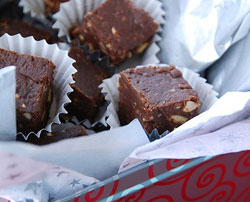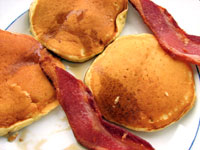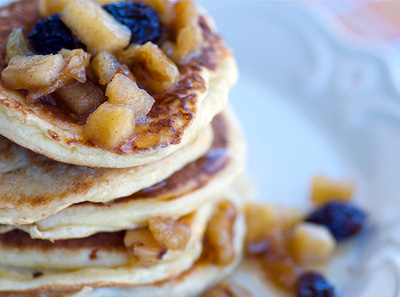 Still looking for the perfect Christmas gift that is easy, inexpensive, and loved by all?
Still looking for the perfect Christmas gift that is easy, inexpensive, and loved by all?
Your problem is solved: give the gift of fudge! That's right. Mix up a few batches, pop them in some festive foil baking cups, and nestle them in decorative tissue paper and tins. Then kick back with a hot chocolate and enjoy your favorite Christmas movies while everybody else kills themselves looking for a parking space at the mall.
No baking is required. None. Zip. It can be made ahead and refrigerated, so it saves you time. Plus, each batch costs only a few dollars and can be made in less than 10 minutes.
Christmas
Christmas
The Devil's Eggnog
 I made eggnog from scratch once for a party, during college. It was positively amazing. It consisted of sugar, brandy, heavy cream, eggs and a pinch of nutmeg. It ought to have been called devil's nog. The stuff was pure evil! But tasty.
I made eggnog from scratch once for a party, during college. It was positively amazing. It consisted of sugar, brandy, heavy cream, eggs and a pinch of nutmeg. It ought to have been called devil's nog. The stuff was pure evil! But tasty.
Sadly the eggnog you buy at the store is nothing like the eggnog I made. It's not fluffy and boozy, just cloying and thick. Every year I forget this and buy a quart. So this year after my first disappointing cup I decided to cook with it instead of drinking it. For years I've seen recipes for eggnog pancakes. But when I went to make them my printer wasn't working and I was too lazy to write down the ingredients. So I made up my own version. It turned out surprisingly good.
Eggnog is really not much different than a custard. You could use it in all sorts of recipes. You can make milkshakes out of it or use it in french toast, bread pudding, pot de creme, ice cream, and maybe even crepes. If you have a favorite use for leftover eggnog let me know about it.
Oh Christmas Tree
 No wonder I rarely got a tree. It’s just too much work. Going out to buy it. Schlepping it home. Carting it inside. Pine needles everywhere. Finding the box with the decorations in storage. Untangling the lights. Discovering that only some are still working. I’m not that together. I have zero organizational skills. Hey, if magical elves appeared in my home to set up the tree, and I didn’t have to go to the lot or do anything, I would reconsider.
No wonder I rarely got a tree. It’s just too much work. Going out to buy it. Schlepping it home. Carting it inside. Pine needles everywhere. Finding the box with the decorations in storage. Untangling the lights. Discovering that only some are still working. I’m not that together. I have zero organizational skills. Hey, if magical elves appeared in my home to set up the tree, and I didn’t have to go to the lot or do anything, I would reconsider.
And then, of course, there is the religion factor. To get a tree or not to get a tree. Since half of me is Jewish and the other half vague, it’s easier to just call myself a Jew. A tree never seemed to bother other Jewish families when I was growing up in Beverly Hills. This time of year, everyone became his or her own Hollywood set decorator. Each family outdid the next. Talk about keeping up with the Joneses --only in this case the Jimmy Stewarts.
Lets’ face it a Christmas tree is an indicator of taste. Pink-flocked ones seem a bit “Liberace” to me. But I kind of dig a pink tree. A very close friend growing up lived in a home with wall-to-wall white shag carpeting and lots of gaudy gold-trimmed fixtures. Her prematurely blue-haired mother always matched their blue-flocked Christmas tree. Each year I thought wow, everyone’s trees are getting bigger and bigger. Like bigger is better. They seemed to reach the ceiling in some homes and I would think, okay, we can see you have a big penis.
Don't Forget Christmas Day Breakfast
 Jeff and I have been starving ourselves for the past few days. Well, not actually starving. We did have our morning coffee. Oh, and I sneaked in a couple of double chocolate pomegranate cookies yesterday. But those don't count. I was recipe testing.
Jeff and I have been starving ourselves for the past few days. Well, not actually starving. We did have our morning coffee. Oh, and I sneaked in a couple of double chocolate pomegranate cookies yesterday. But those don't count. I was recipe testing.
Why are we starving ourselves? Because on Christmas Eve night, we will be enjoying a traditional Italian Feast of the Seven Fishes. That means fried calamari, fried smelts, and crab cakes. Snail salad, bacala (a dried, salted fish), and shrimp cocktail. (Those are just the starters.) Then comes the pasta. Two types of pasta, actually -- one with mixed seafood including shrimp, scallops, and lobster; the other with olive oil, clam sauce, and parsley. Then we'll finish with jumbo stuffed shrimp and garlicky broccoli rabe.
The Soup That Saved Christmas
 No one wants a face full of snow. But that’s what I had all too often
growing up in those brutal Chicago winters. I always seemed to be in
the middle of a blizzard walking against gale force winds – which is
why I spent more time walking backwards than I did forward.
No one wants a face full of snow. But that’s what I had all too often
growing up in those brutal Chicago winters. I always seemed to be in
the middle of a blizzard walking against gale force winds – which is
why I spent more time walking backwards than I did forward.
And no one wants to step into slush. But when I did, my mother would
put my shoes in the oven. Usually about thirty minutes too long. My
shoes would come out smoking and ruined, which was not unlike many of
our family dinners.
And no one wants to be a poster child for static electricity. But the
winter air was so dry that my hair repelled my brush, my pants clung to
my socks, and touching anything would send enough voltage through me to
light up Soldier Field.
Those were not a few of my favorite things.
So when Christmas vacation would approach, I was pretty much champing at the bit to get out of Dodge.
But it never happened.
More Articles ...
Welcome to the new One for the Table ...
Our Home Page will be different each time you arrive.
We're sure you'll find something to pique your interest...

